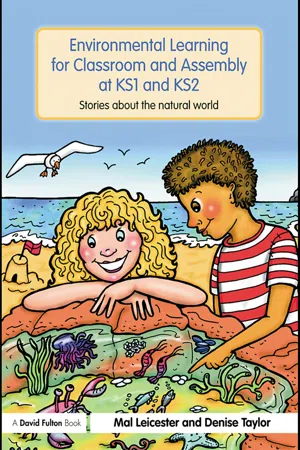
Environmental Learning for Classroom and Assembly at KS1 & KS2
Stories about the Natural World
- 136 pages
- English
- ePUB (mobile friendly)
- Available on iOS & Android
Environmental Learning for Classroom and Assembly at KS1 & KS2
Stories about the Natural World
About This Book
In Environmental Learning for Classroom and Assembly at KS1 & KS2, the highly successful and popular author Mal Leicester teams up with the conservationist Denise Taylor to teach children about wildlife and environmental conservation through the art of storytelling. Reflecting the child's world, the book works outwards from home to garden to neighbourhood to the countryside and seaside and to the planet as a whole. At each level, appreciating, conserving, and enhancing our environment is considered.
The authors follow the tried and tested format of Stories for Classroom and Assembly and Stories for Circle Time and Assemblies. Each of the ten chapters includes an original themed story and is packed with lesson plans and cross-curriculum learning activities designed to save teachers' valuable time. Leicester and Taylor combine the wonder of storytelling with topical environmental issues, covering plants, creatures and the planet. The book covers the full range of conservation, protection and enhancement themes, concepts and values whilst developing the following skills:
- literacy (including oracy)
- numeracy
- knowledge of the natural world
- imaginative development
- creative expression.
Making a highly topical and on-going subject accessible to children, this beautifully illustrated resource offers teachers assembly ideas, lesson plans and art activities all in one book.
Frequently asked questions
Information
CHAPTER 1
My Home is an Ecosystem
Theme One: My Home is an Ecosystem
- Appreciation: Appreciation of the flora and fauna at home.
- Conservation: Conserving creatures in the home environment.
- Protection and enhancement: Valuing biodiversity in the home environment.
- How can we learn to understand and appreciate nature in and around our own homes?
- The teacher ensures that the children understand the words given.
- The teacher shows the illustration and reads the story.
- The teacher uses some of the questions and discussion points given, stimulating the children to talk about the story/theme.
- The story activities encourage listening and discussion skills. Follow-up activities introduce environmental appreciation and understanding of the natural world in a home environment context. For environmental education, these activities encourage environmental values (e.g. appreciation/respect for the natural world), environmental concepts (e.g. biodiversity), and good environmental behaviour. In terms of personal development they also encourage listening skills, self-confidence and understanding the differences of others (by others we mean different species as well as people from other races, cultures or religions who might be different from ourselves).
1 INTRODUCE THE THEME
- Children are aware of the conservation issues affecting endangered species such as tigers, whales, pandas, turtles, etc., and may be aware of the ecosystems they live in. But in every home there are mini ecosystems to be explored. How many creatures share our living spaces – the home, garden, street and neighbourhood?
- Which creatures share our living spaces?
- How do they interact with us, each other and with other species?
- What do we mean by biodiversity? Why do we value it?
- Understanding family groups in other species.
- Understanding the basic principles of life-cycles, food chains, and predator/prey relationships.
- How can we develop tolerance of others?
- How can we learn to confront our fears?
2 VOCABULARY
Story vocabulary
| Shrieked | – | high-pitched scream |
| Dashing | – | moving fast |
| Patiently | – | able to wait |
| Pretend | – | to make believe |
| Mottled | – | marked with smears of colour |
| Abdomen | – | stomach or lower body |
| Scuttled | – | scurried along |
| Bolted | – | ran fast |
| Funnel | – | a tube or tube-like structure |
| Retrieved | – | found and brought back |
| Spiderling | – | a baby spider |
Associated environmental vocabulary
| Predator/prey relationship | – | the relationship between animals that hunt and those that are hunted |
| Micro ecosystem | – | a small or mini ecosystem |
| Food chain | – | the process of living on a smaller or weaker animal or plant in an ongoing chain |
3 ILLUSTRATION AND STORY
Lottie and Lily Longlegs

Lottie and Lily Longlegs
Table of contents
- Cover Page
- Title Page
- Copyright Page
- Introduction
- 1 My Home is an Ecosystem
- 2 My Garden
- 3 My Neighbourhood: the built environment
- 4 My Neighbourhood: parks and green spaces
- 5 The Countryside
- 6 The Seaside Environment
- 7 Countries Far Away
- 8 The Planet
- Resource List